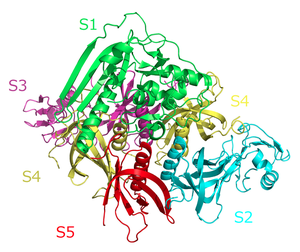Bordetella pertussis Vaccine
Before the invention of its vaccine, Bordetella pertussis was one of the most prevalent childhood illnesses and a major cause of infant mortality. The vaccine became widely available during the 1950s and 1960s, leading to a reduction in incidence of over 90% worldwide [1]. Recently the number of Bordetella pertussis cases has been on the rise, and several minor epidemics have broken out in highly vaccinated countries. This indicates that the vaccine may be failing. Researchers have begun to investigate the sources of these failures.
Whooping Cough
Background
Whooping Cough if an infection of the respiratory tract caused by the bacterium Bordetella pertussis, a small gram-negative bacterium that adheres to the mucosal lining of the respiratory tract. The disease is most frequently diagnosed in children ages 1-5 and presents itself as a moderate to severe respiratory infection with characteristic “whooping” coughing fits followed by vomiting. The disease has an incubation period of 9-10 days and symptoms can persist several months after they first manifest [1]. When infants contract the disease, it can manifest as apnoea and cyanosis without any cough whatsoever. Infants have the highest rate of mortality due to the pertussis infection. In older children and adults the disease often manifests in unexpected and varying ways, making it difficult to diagnose [7].
Pathogenesis
Current Vaccine Options
DwP Vaccine
The DwP pertussis vaccine, or the whole-cell vaccine, was developed during the early 1900s using dead cells of the Bordetella pertussis bacteria. It became prevalent in many developed nations during the 1940s and 1950s and effectively brought the disease under control [8]. When it first came into use, the vaccine was delivered 3 times throughout early childhood. Because localized reactions tend to increase with age, as the immune system increases in strength, this vaccine is not approved for adolescents or adults. Currently, the vaccine is based on standardized strains of B. pertussis that are killed and often treated with formalin; however, the exact method of production varies among manufactures. Each vaccine undergoes rigorous testing that assesses potency, toxicity, sterility, and bacterial concentration. Aluminum salts are always added to the wP vaccine as an adjuvant. Thiomersal and other preservatives may also be present in the vaccine. Unfortunately, this vaccine elicits a strong immune response that leads to adverse reactions in 1 out of every 2-10 inoculations. The vast majority of these reactions are minor and temporary, such as redness and swelling at the injection site, slight fevers, and agitation [1]. However, some individuals, when exposed to live or dead forms of this bacterium, have a severe reaction mediated through pro-inflammatory cytokine induction within the central nervous system. This response leads to extreme fevers, convulsive encephalopathic symptoms. Although these effects are also temporary, they have lead to speculation on the safety of the vaccine [6].
DaP Vaccine
Currently, the preferred vaccine in most industrialized nations is the acellular vaccine. The earliest form of this vaccine was created in 1981 by a Japanese researcher. The current aP vaccine is made up of 5 different antigens: PT, FHA, PRN, and FIM type 2 and type 3. The vaccine differs significantly from one manufacturer to the next, as there are no standardized strains from which these antigens are purified from, and no standardization for the processes of purification, detoxification, or incorporation of adjuvants and preservatives. This vaccine is usually administered 4 times during childhood and once more during early adolescence. In order to combat the increased strength and consequently reaction of an older immune system, the “boosters” after the original inoculation contain lower concentrations of the antigens, in order to minimize their reactogenicity [1]. The aP vaccine has been successful because it effectively minimizes the adverse side effects so prevalent in the wP vaccine. When side effects do manifest they are less severe, never resulting in seizures, and much less frequent [6].
Recent Vaccine Failures
Incidents
Differences in Vaccine Efficacy
Other Hypotheses for the Failures
The Search for Improvement
References
Edited by Kristina Millar, a student of Nora Sullivan in BIOL168L (Microbiology) in The Keck Science Department of the Claremont Colleges Spring 2014.

